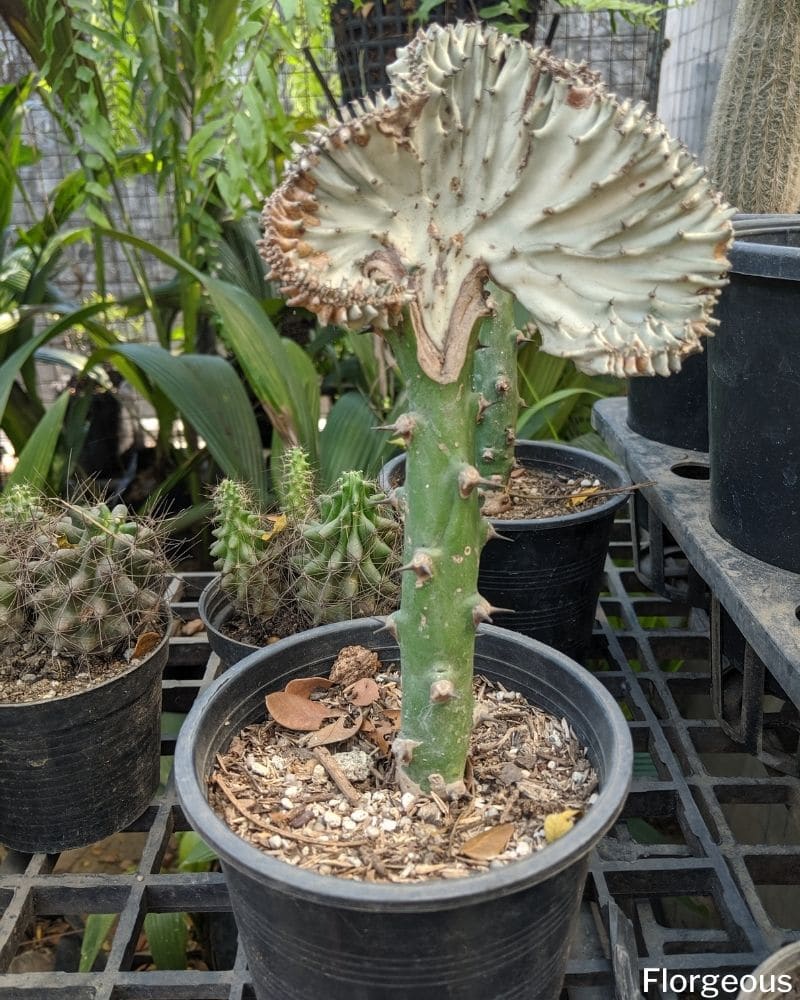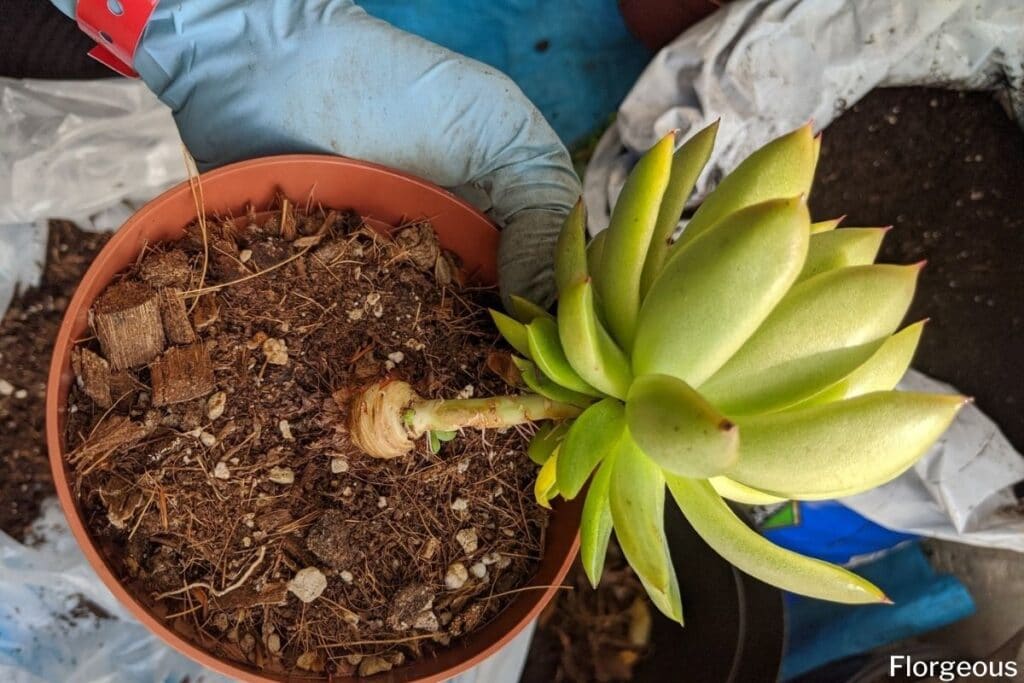Collecting succulents is absolutely an exciting and satisfying endeavor. There are so many species, varieties, and hybrids to hoard and almost every literature says they are very easy to grow and keep, so all you really need to do is provide space with the right environment for these plants.
But despite their ability to flourish without much attention, there are several maintenance practices that these houseplants need in order to remain fascinating and also to keep growing and producing more plants for you. One of these key practices is repotting your succulents.
Why Should You Repot and Replant Your Succulents?
As a succulent owner, knowing how to pot succulents is a vital and basic skill to have. Learning how to repot and transplant succulents is also very crucial if you want your plants to keep growing and stay healthy.
Repotting is an occasional but essential gardening activity that helps the overall growth and health of plants. Most importantly, it provides the plant’s roots sufficient drainage, soil minerals and nutrients, as well as enough aeration and room for them to breathe and grow (1).

There are numerous situations that call for repotting and transplanting of your succulents. Although it is customarily done every 2 or 3 years, the condition and even the plant itself indicates when it is time to do this.
It helps that you give your succulents enough attention to identify if they really need repotting.
Newly Purchased Plants
Succulents from nurseries and plant stores usually come in soil mixes that lean towards more organic matter content. These plants require a gritty potting mix that helps with drainage and breathing of the roots so changing the soil is necessary.
Repotting may add to the stress that the plant is already experiencing after being transported from the store but it is better to proceed with this than to let the plant adapt and then subject it to stress again later on.
It will also allow you to check for signs of pests and diseases and assess the physical condition of the plant.

Overcrowding and Being Root-bound
After a year or two, healthy succulents, especially the mat-forming kinds like Sedum and Crassula, will overgrow their pots. This will give an appealing thick and bushy growth but it can later result in poor growth as the plant uses up the nutrients and space in the pot.
Although not all succulents develop an obtrusive root system, they will grow fuller and may cause the plant to become root-bound wherein the roots almost entirely occupy the space in the pot, restricting the plant’s growth.
Repotting will provide the plants more room to grow and more nutrients from the new soil. It will also give you the opportunity to propagate and make new plants from the overgrowths of your succulent.

Compacted Soil and Poor Drainage
Water makes the soil clump together and over time. The soil in the pot becomes too compacted that the rate of percolation is too slow.
Oftentimes, the water stays on top of the soil without getting the root ball wet. This can lead to dehydration and rotting of the stem and the way to alleviate is to aerate the soil or replace the soil completely.
Some pots may also have tiny drainage holes that can get clogged easily with soil debris and pebbles from the soil mix. Poor drainage causes the soil to get too saturated resulting in root rot so repotting helps give the plant better drainage.
Unhealthy-looking Plants
Sometimes, your plant may look sad, showing symptoms like yellowing, wilting, and leaf fall and you are not sure what the problem is. It may be due to succulent pests and disease, lack of nutrients, etc. but if you do not find any signs of these on the upper part of your succulent, most of the time it has something to do with the roots and the soil.
Repotting the plant will help you closely monitor the roots and get rid of soil-borne problems. An advantage of repotting is identifying diseases like root rot which are invisible at the onset of their occurrence.

Damaged Pots
Pots add charm to indoor plants, particularly the decorative ones. If the pot gets damaged due to mechanical factors or the plant being root-bound, repotting should be performed. This will keep the soil and the roots from falling apart and make the set up more aesthetically appealing.
What’s The Difference Between Potting and Repotting?
Potting and repotting both involve the transfer of plants to a new potted environment. However, potting refers to moving a seedling with a developed root system into its permanent pot while repotting is transferring a plant into a bigger container that will better accommodate its growth (2).
When Is The Best Time to Repot?
How to know when to repot succulents? This is a key factor to determine your success because not all succulents are created equal.
There are different types of succulents and although they share the same preferences when it comes to growing conditions, some of them go dormant while others do not. This dormancy should be considered when repotting them.
As opportunistic growers, succulents are able to adjust to their environment and regulate their growth when necessary.
Plants like Adenium, Echeveria, and Sempervivums are summer growers and have reserved growth throughout winter. They actively grow in spring so this is the best time to repot them.
Winter growers like Aeonium, Haworthia, and Pachyphytum are active in the fall so repot them during this time. Avoid repotting when the succulent is dormant as this will disturb their resting period and may prevent the plant from growing back.
Succulents that do not go dormant can be repotted any time of the year (3) but conveniently during spring.
How do you know if the plant is root-bound?
Since you can readily inspect only the top half of your succulents, it may be difficult to recognize if they are already root-bound. What you can do is lookout for signs like roots growing out of the pot’s drain holes, dry soil, and yellowing of foliage (1).
What Do You Need to Repot?
Soil
Having the right type of soil is the first important ingredient when it comes to learning how to transplant succulents.
The potting mix for newly planted succulents should be 70 to 80% mineral material and 20 to 30% organic material. It should be gritty to mimic the natural growing potting medium of the plants but porous enough to hold the roots and provide enough moisture.
Mineral materials include coarse sand, perlite, fine gravel, and volcanic rock. Organic materials may be a mixture of soil and any of coconut coir, pine bark, or compost.
The plant may also benefit from including slow-release fertilizer into the mix to gradually supply the plants with key nutrients.
Container
Your container or pot should be bigger than the previous one to have enough room for growth. Decorative or plain, it should be sturdy enough to hold the plant and soil, lightweight to ease moving and rotating, and have enough holes at the bottom for proper drainage.
Pots are made from different materials like plastic, terra cotta, ceramic, concrete, etc. You can choose based on preference but it also helps to know that these types of containers vary in durability, water retention, and heat dissipation.
Mulch Material
Top-dressing the succulent plant with a pebble mulch does not only regulate the moisture in the soil but also keep the upper half of the plant from unnecessarily touching the soil.
Like cacti, succulents can easily rot when there’s too much water so this protective layer will help keep the stem and leaves dry.
Tools
Proper planting tools should be used when transferring and replanting your succulents. You will need a small shovel to scoop soil mix and pebbles into the pot, a two-pronged fork to lift the plant without damaging it, and scissors to help prune unwanted leaves, stems, and roots.
You will also need gloves to protect your hands from the sap, soil, and fertilizer, bubble wrap or old newspaper to help handle spiny plants, a plastic cover or tarp to protect your surface from the repotting mess, and a small piece of mesh to put at the bottom of your pot to prevent the soil from coming out of the drainage holes.

How To Repot a Succulent
When it comes to succulents care, repotting your plants may sound laborious but it is necessary and actually fairly easy, given that you only need to do it once every so often.
Follow these simple steps to properly repot your succulents and keep them lasting.
- 1. Water plant 2 to 3 days before repotting. This will make the soil moist enough to easily pull the plant out of the old pot and at the same time provide the plant with enough moisture reserve before the next watering.
- 2. Cover your working surface to protect from dirt and clean up easily. Wearing gloves, expose the roots by removing the surrounding soil, especially if the plant is new. During this time, inspect the root system for any decay and pests and trim away brown roots using a sterilized pair of scissors. Handle your plants with a fork or wrap them in a newspaper to avoid damage to the plant and to prevent your hands from possible irritants. Many succulents like Sedum morganianum have delicate leaves that can easily fall off so be mindful of this.
- 3. Remove dry leaves and stems for disposal. If your succulent has produced big enough plantlets, this is the best time to divide and propagate. Carefully remove these pups by creating clean cuts on the mother plant and plant them separately.
- 4. Use a pot wider than the body of your succulent. A diameter double the size of the root system will provide more room for expansion. Check if the pot has sufficient drainage holes and put a piece of mesh at the bottom to keep the soil from falling through the hole.
- 5. Depending on the depth of the pot, pour your cactus potting mix 2 to 3 cm high. Holding your succulent in one hand, carefully place it in the middle of the pot and gently pour more mix around the plant. Pat the soil around the stem and poke with the fork to make sure that there are no big air packets. Add more soil until the roots are covered but do not fill up to the rim.
- 6. Spray the soil with water and top-dress with pebbles. Place the plant in a well-ventilated, bright location, and then after 2 to 3 days, water your succulent thoroughly. Allow the plant to adjust to its new container before treating it like you would your old succulents.
FAQs
How do you repot a succulent without killing it?
Gently remove the succulent from its old pot, trim any damaged roots, and replant it in a new pot with well-draining soil. Water lightly and allow it to adjust.
Can you break off succulents and replant?
Yes, many succulents can be propagated by breaking off a healthy leaf or stem and replanting it in soil.
Do succulents go into shock after repotting?
Succulents may experience temporary shock after repotting, resulting in wilting or color changes. With proper care, they typically recover quickly.
We hope you enjoy this repoting succulent guide. If you are interested in expanding your collection, make sure you learn how to propagate succulents. It’s a helpful skill to have, too.
See more: how to repot a cactus
References
Reference List:
(1) Bailey, F. & Allaway, Z. Practical Cactus and Succulent Book. Penguin. 2019. P. 224.
(2) Randhawa, G. & Mukhopadhyay, A. Floriculture in India. Allied Publishers. 1986. P. 660.
(3) Singh, D. & Davidson, J. Introduction to Succulents and Cacti: Cacti Culture for Newbies. Mendon Cottage Books. 2019. P. 76.
Close







